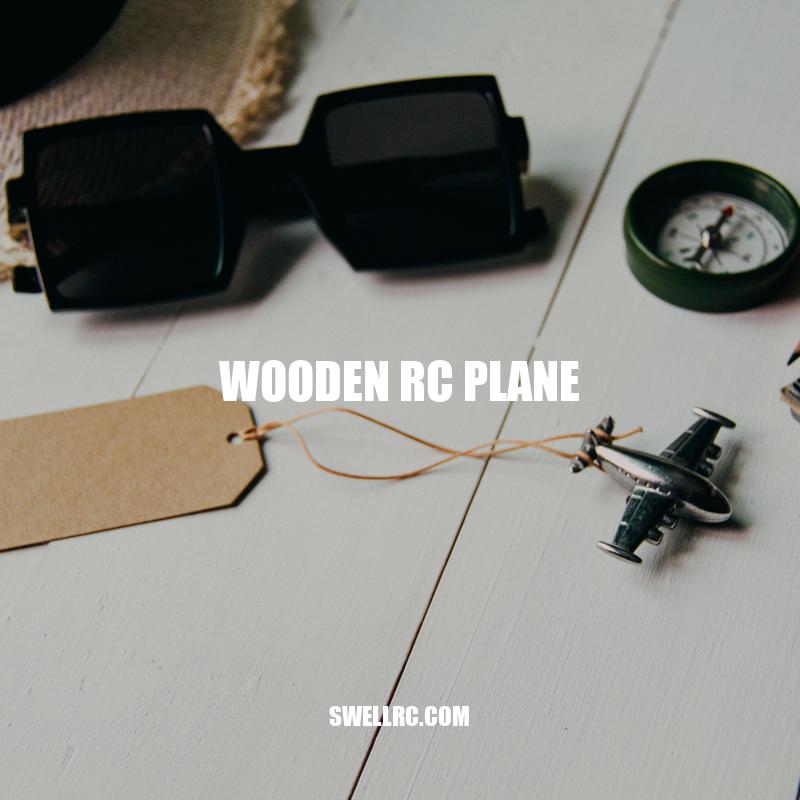Crafting and Flying Wooden RC Planes: The Ultimate Guide
Wooden RC planes have become quite popular among hobbyists, as they are proving to be a more customizable and durable option compared to other material types. While plastic and foam have traditionally dominated the market, there is a growing appreciation for the craftsmanship and beauty of wooden aircraft. One of the main appeals of wooden RC planes is the ability to modify and personalize the model as desired. The wood’s pliability allows for more intricate designs, which cannot be achieved with plastics or foams. Furthermore, wooden RC planes are naturally lightweight, making them more maneuverable and agile in the sky. They allow for more intricate aerial displays and acrobatic manoeuvres. Additionally, wooden planes are easy to repair, provided that the builder knows what they are doing. They can be brought back to flying condition with basic woodworking tools and an understanding of how the structure operates.
Advantages of Wooden RC Planes
Wooden RC Planes have several advantages that make them a popular choice among hobbyists. Some of these benefits include:
- Customizable: Wooden planes are easily customizable due to their pliability, which enables builders to shape them as per their preferences.
- Durable: Wooden planes have a more robust structure compared to plastic and foam planes, making them more durable and long-lasting.
- Lightweight: The lightweight nature of wooden planes makes them more maneuverable and agile in the sky, allowing for more intricate flying displays.
- Easy to Repair: Wooden planes are easier to repair than plastic or foam. Most repairs can be performed using basic woodworking tools and some glue.
Overall, the benefits of wooden RC planes make them an attractive option for hobbyists looking for something unique and durable. Thankfully, several websites provide resources and tips for building and maintaining these planes. One such website is RC Airplane World, which offers various models, tutorials and helpful tips for everyone, from beginner to expert builders.
What are the advantages of RC planes?
- Ability to fly and control the plane remotely from the ground.
- Opportunity to learn and improve piloting skills with a model plane before flying a real plane.
- Less risk involved when piloting a RC plane compared to a full-size plane.
- Wide range of models available for every level of experience and interest.
- Ability to customize and modify the plane to specific preferences and needs.
If you are interested in purchasing RC planes, websites such as horizonhobby.com and towerhobbies.com offer a variety of models and accessories.
Building a Wooden RC Plane
Building a wooden RC plane is a challenging and exciting project that requires careful planning and execution. Here are some steps involved in building a wooden RC plane:
| Steps | Description |
|---|---|
| Design: | Develop a plan for the plane, including its size, design and other aesthetics. |
| Choose the type of wood: | Select the type of wood to use, such as balsa, bamboo or spruce, for the different parts of the plane. |
| Cut the parts: | Measure and draw out the different parts of the plane, including the fuselage, wings and tail, and proceed to cut them out using a saw. |
| Assemble the parts: | Join the different parts of the plane together using glue and clamps, ensuring that they align correctly before they dry. |
| Add finishing: | Sand the plane to smooth out any rough edges and apply a coat of varnish or paint for the desired finish. |
It is essential to note that building a wooden RC plane requires patience, precision, and skill. However, the satisfaction and pride that come from successfully building and flying a wooden RC plane are unparalleled. For more information on building wooden RC planes or acquiring necessary materials, one can visit websites such as Balsa USA or the RC Groups forums.
Can you build an RC plane from scratch?
Yes, you can build an RC plane from scratch. However, it requires a good understanding of electronics, aerodynamics and materials engineering. You will need to learn skills like soldering, cutting, and gluing parts together. There are various online resources, such as forums and websites, where you can find tutorials, plans, and support. Some websites sell kits or parts that can help you in your DIY project. It’s essential to have patience and persistence to complete the project successfully.
Maintenance of a Wooden RC Plane
Maintaining a wooden RC plane is crucial in ensuring its longevity and continued performance. Here are some tips on how to take care of your wooden RC plane:
- Keep the plane clean and dry by wiping off any dirt or moisture after each use.
- Avoid exposure to direct sunlight or high temperatures that might cause the wood to warp or crack.
- Check regularly for any signs of wear and tear or damage and replace or repair as necessary.
- Store the plane in a dry and dust-free environment; a properly constructed wooden box or case can help protect the plane from damage.
- Always check the plane before each use, particularly the battery and control systems to ensure they are functioning correctly.
In addition to the above tips, it’s also essential to follow safety protocols when operating the plane, including checking weather conditions and avoiding flying near crowded or restricted areas. For more detailed instructions on how to maintain and care for your wooden RC plane, websites such as The Academy of Model Aeronautics and RC Universe offer valuable resources and forums for enthusiasts.
How do you weather an RC plane?
To weather an RC plane, you need to follow these steps:
- Clean the plane’s surfaces with rubbing alcohol and let them dry completely
- Apply a light coat of primer and let it dry completely
- Spray the plane with a base color and let it dry completely
- Apply a top coat with a different color or shades of the same color, and let it dry completely
- To add a weathered effect, you can use sandpaper, a toothbrush or a sponge to gently scrape away some paint, revealing the base coat underneath
- Finish by applying a coat of clear coat or varnish to protect the paint job
If you’re new to RC planes and need help, check out websites like RC Groups or Horizon Hobby for resources and products to get started.
Flying a Wooden RC Plane
Flying a wooden RC plane can be a lot of fun, but it’s essential to do it safely and successfully. Here are some tips for beginners:
Check Weather Conditions
Always check the weather forecast before flying; it’s essential to avoid flying during windy or rainy conditions, which may harm the plane’s stability and your flights’ reliability.
Choose an Appropriate Location
Ensure that you choose a suitable location for your flying. Choose an open, flat area, away from trees or buildings, as they may interfere with your signal or cause your plane to crash.
Practice Before Attempting Complex Maneuvers
Achieving aerial acrobatics is a result of consistent practice. Do not attempt any complex maneuvers if you’re still new to flying. Practice with basic movements until you get a better feel of the plane’s behavior and become confident enough to progress.
Make sure you have the right equipment and battery, and that all the systems are properly functioning before launching your plane. For additional tips on flying and operating RC planes, websites like Fly RC Magazine and RC Helicopter Fun offer great advice and resources from experienced and skilled RC plane enthusiasts.
How do you fly an RC plane for the first time?
If you’re in need of an RC plane for your first time, check out websites like Horizon Hobby or Amazon for a wide range of options.
Conclusion
In conclusion, wooden RC planes are excellent alternatives to plastic or foam planes, given their customization capabilities, sturdiness, and overall classic look. With the right tools and knowledge, anybody can build a wooden RC plane and enjoy the thrills of flying it. Proper maintenance and flying techniques are essential for the plane’s functionality and longevity, while online resources and websites like Fly RC Magazine and RC Helicopter Fun can provide insightful advice for beginners and experienced hobbyists alike. If you’re considering trying out building and flying an RC plane, a wooden one could make for a great choice. Overall, building and flying an RC plane is an incredibly fulfilling and rewarding experience that combines the technical and the artistic into a unique and enjoyable hobby for all ages.



